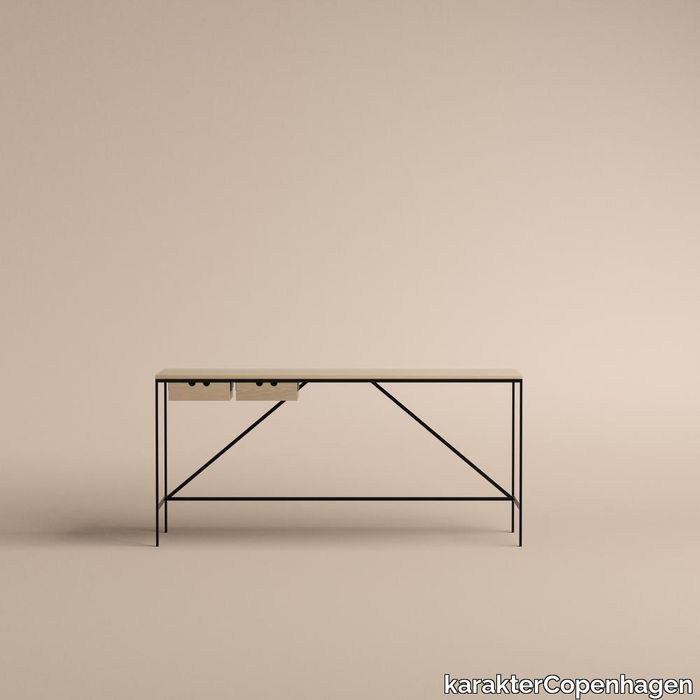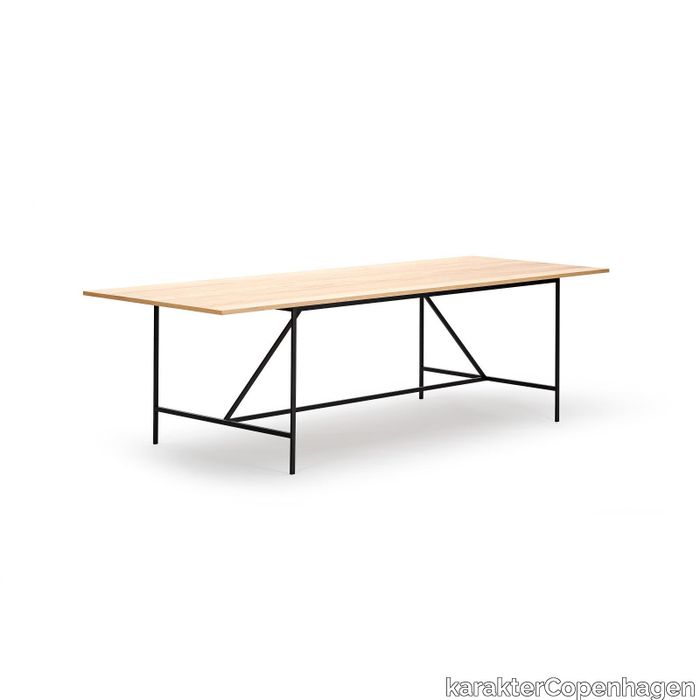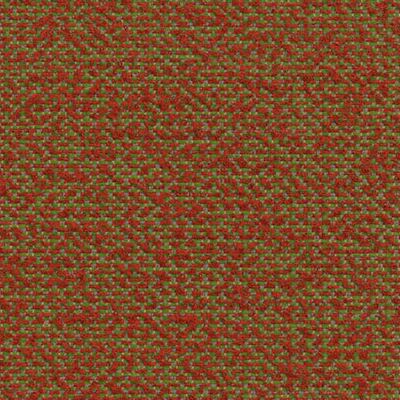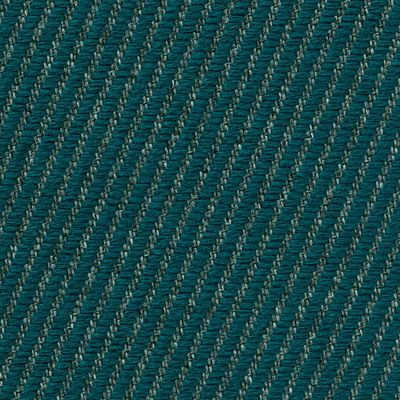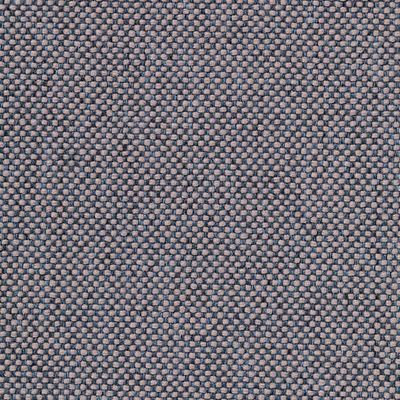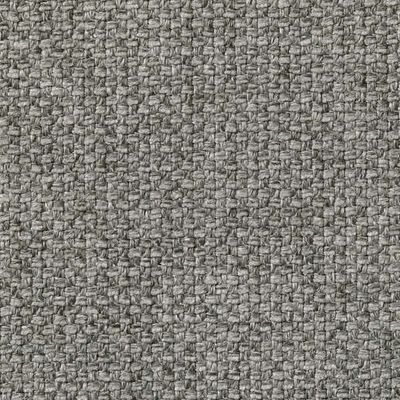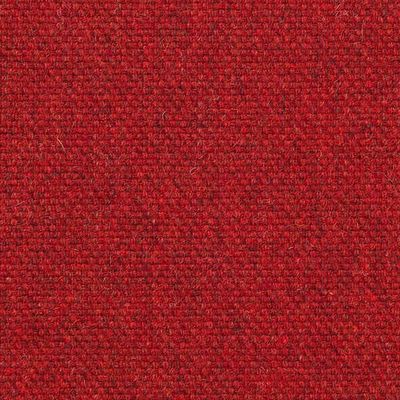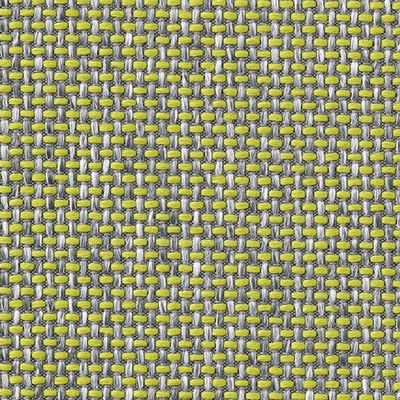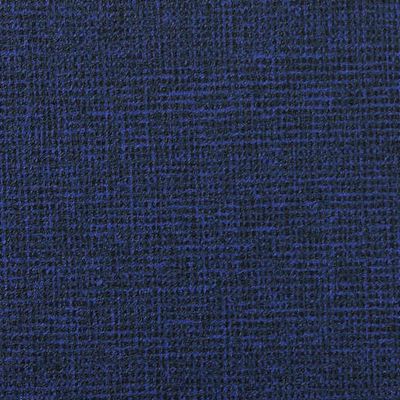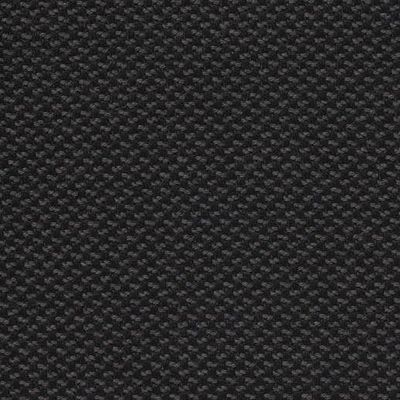PRODUCT DESCRIPTION
The foundation of the Cache series, part of Paul McCobb’s extensive Planner series, is a beautifully simplistic and easy table with slim and straight steel legs, stripped from any details or ornament, leaving only small drawers that can be mounted individually or grouped on either side of the table for small keepings. The series is complimented with the matching Desk Organiser with two drawers and a shelf supported by a steel frame. A prominent figure in American mid-century design, Paul McCobb conceived the Planner series in the 1950s, a modular furniture series that brought modern design into middle-class American households. The aesthetic attribute of McCobb’s design is sleek and unadorned and at the same time warm and approachable. With its versatility and purity of form, the Planner series became one of the most successful commercial furniture lines of its era.
SUPPLIER: KARAKTERCOPENHAGEN
TYPE: FURNITURE

OTHER SUPPLIERS
A wide range of product from near to 3,000 suppliers around the world.






Other Products From This Supplier
A wide range of product from furniture to finishes to meet the desire of all designers.
Jazz Max Brüel, 1961

karakterCopenhagen > Styling
Elegant and with a hint of whimsy, the modular candleholder Jazz was conceived in 1961 by Danish architect, ceramist and jazz musician Max Brüel. A slender, graceful silhouette in three heights, Jazz is an elegant addition to the home – by itself or in groups. A Jazz candleholder comes with a top, a base and three interchangeable stems in different heights to fit any occasion.
Office Desk Bodil Kjær, 1959

karakterCopenhagen > Desk
We are proud to present our first design from a Danish designer. In this case, Danish architect, professor, and designer, Bodil Kjær. The iconic desk, designed in 1959, was the first of its kind with its pure and simplistic design, almost floating mid-air. Bodil Kjærs’ design has been called ‘The most beautiful desk in the world’ – or, the ‘James Bond desk’ as it was featured prominently in three early Bond movies.
Scarpa 925 Afra & Tobia Scarpa, 1966

karakterCopenhagen > Chair
The iconic 925 Scarpa lounge chair is a strikingly elegant lounge chair. Easily recognized by its firm and robust wooden frame and the striking contrast it creates to the lightness of the leather covered seat and backrest. The anatomical design of the leather-covered seat, combined with the natural elasticity of the cantilevered backrest, creates a lounge chair that is equally comfortable and strikingly elegant. The 925 Scarpa lounge chair was designed alongside the charming 121 Scarpa dining chair from 1965. The two chairs are a prime example of Afra and Tobia Scarpa’s work and share the same double trestle structure with characteristic rounded joints. Both designs are now a part of the Karakter collection.
Sferico Joe Colombo, 1968
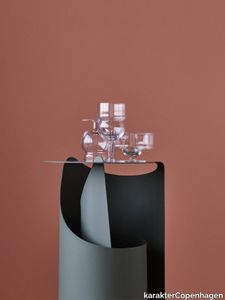
karakterCopenhagen > Styling
Joe Colombo believed in democratic and functional design. In his lifetime he designed a wide range of different drinking glasses. Something that seems very to the point as he was said to love drinking and smoking. Unfortunately this undoubtedly contributed to his young demise, but we’d like to think he would be pleased to see that his creations live on. In 1968 he designed a series of six glasses, all based on geometrical figures. True to his democratic and functional take on design, all the glasses were intended for a wide range of different usage—such as water, long drinks, whisky, wine, beer, juice, champagne, ice cream and so on. Karakter is proud to bring some of the very finest glasses to your table and will introduce the six different Joe Colombo glasses.
Heddles throw Karin Carlander, 2022
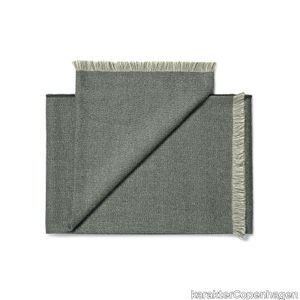
karakterCopenhagen > Styling
Weaver and textile artist Karin Carlander interprets classic techniques as the backbone of her creative process. Two new designs – a rectangular rug woven from paper yarn and a fringed throw in alpaca wool – showcase this craftsmanship in contemporary pieces for the home. When it came to the Heddles throw, Carlander selected alpaca wool from the Andes mountains. These thin, glossy fibers were woven into a luxurious blanket that features a subtle ridged design. Along the throw’s edge, a delicate fringe invites a closer look at the construction process, which sees the loom’s warp and weft working together. “This analogue way of creating is a collaboration between my loom and the material,” says Carlander. “The way threads and colours perform is new and unexpected with each material. Even after so many years, the craft continues to surprise me.”
Scarpa 121 Afra & Tobia Scarpa, 1965

karakterCopenhagen > Chair
The iconic 121 Scarpa dining chair is a straightforward dining chair with a design that can complement both classical and cutting-edge interiors. The design is characterized by a firm and robust wooden frame that creates a striking contrast to the lightness of the seat and back. The seat and back are anatomically shaped in plywood, covered in fine European leather, and attached by bolts to crosspieces along the center for great comfort. Originally inspired by a sketch made by Tobia’s father, Venetian architect and designer, Carlo Scarpa, the 121 came to life with a distinct touch from Afra and Tobia Scarpa in 1965. The 121 Scarpa dining chair was designed alongside the classic 925 Scarpa lounge chair from 1966. The two chairs are a prime example of Afra and Tobia Scarpa’s work and share the same double trestle structure with characteristic rounded joints. Both designs are now a part of the Karakter collection.
Principal dining table Bodil Kjær, 1961

karakterCopenhagen > Table
One of the last living mid-century Scandinavian design pioneers and a female pioneer in the field of architecture in her time, Bodil Kjær, conceived her Principal series in 1961 as part of an architectural exploration of interior solutions for modern living, called Elements of Architecture. Comprising a dining table and an upholstered dining chair, the Principal series epitomises Kjær’s forward-thinking cosmopolitan outlook and modernistic design language that slips fluidly into contemporary interior. The solid wood dining table boasts a clarified form, repeating a simple angle throughout table legs and ends of the table top, while the dining chair with its circular seat and gently rounded backrest, beautifully upholstered, adds a softness to the clear, unfussed geometry, an invitation to linger.
Cross Plex table Bodil Kjær, 1959

karakterCopenhagen > Coffee table
The CrossPlex Low Table was created as part of Kjær’s forward-thinking functional Elements of Architecture furniture program developed between 1955 and 1963. Over the decades this crisp occasional table has retained its timeless appeal, making it a welcome addition to a range of contemporary settings. Constructed of a cruciform acrylic base that supports a square glass top, the inherent transparency of the CrossPlex brings an air of lightness to the room.
Domo Floor Joe Colombo, 1965
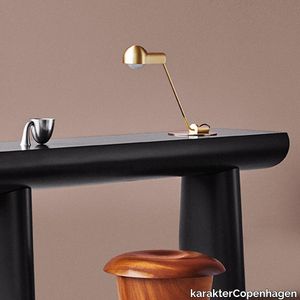
karakterCopenhagen > Floor lamp
The Domo lamp was originally designed by Italian designer Joe Colombo in 1965. Back then he designed three lamps based on the same core shape. Known for his democratic and functional design, his flexible and convertible furniture meant to be used in many different ways – all to the benefit of the user. Joe Colombo experi-mented with new materials and the latest technologies and designed futuristic “machines for living”, many of which have become icons for a new way of living. One of them is Domo. Colombo often rejected sharp corners and straight lines in favour of curvaceous forms.
Domo Table Joe Colombo, 1965
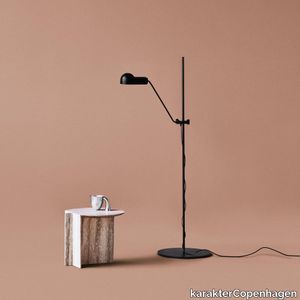
karakterCopenhagen > Table lamp
The Domo lamp was originally designed by Italian designer Joe Colombo in 1965. Back then he designed three lamps based on the same core shape. Known for his democratic and functional design, his flexible and convertible furniture meant to be used in many different ways – all to the benefit of the user. Joe Colombo experimented with new materials and the latest technologies and designed futuristic “machines for living”, many of which have become icons for a new way of living. One of them is Domo. Colombo often rejected sharp corners and straight lines in favour of curvaceous forms.
Bon Aldo Bakker, 2017
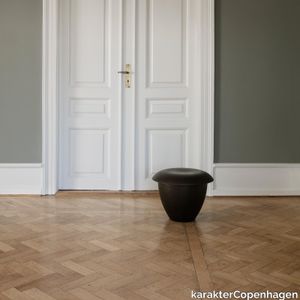
karakterCopenhagen > Stool
A rework of Dutch artist and designer, Aldo Bakker’s wondrous Pink Stool in urushi lacquer from 2015, Bon in stained ash exudes Bakker’s accomplished sense of serene form and materiality. The sculptural stool consists of two contradictive container shapes put together: an upright and deep vertical shape and a flat horizontal shape that defines the seating.
Aida Angelo Mangiarotti, 1988
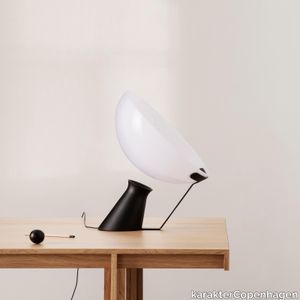
karakterCopenhagen > Table lamp
Esteemed for his researched and controlled approach to materials, Italian architect, sculptor and designer Angelo Mangiarotti created the almost gravity-defying Aida lamp with its visual disconnect between the base and shade and a pleasing ambient light. Referencing principles of his hailed architecture, where slim, elegant pillars support large and heavy ceilings in an almost impossible lift, Mangiarotti conceived Aida’s beautifully poised silhouette.
Hang Around large Derek McLeod,Joy Charbonneau, 2023

karakterCopenhagen > Styling
Hang Around is an updated version of the classic coat rack. Spacious and sturdy, Derek McLeod and Joy Charbonneau’s Hang Around has a soft, rounded expression that contrasts well to the sturdiness of the design. The dedicated pegs and their respective bars will add a welcoming and distinctive vibe to hallways and bedrooms, waiting areas, hotels, and restaurants. Produced in metal, the Hang Around is available in a large version with seven pegs, and in a small version with four pegs.
Lari Angelo Mangiarotti, 1978
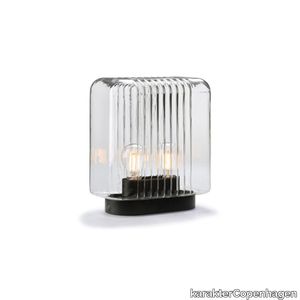
karakterCopenhagen > Table lamp
The Lari Lamp, mouth blown in one single piece, that are held together by the base, which also supports the electrical system evokes, on a small scale, some suggestions of Angelo Mangiarotti’s previous architecture.
Awkward Light Anatomy Design, 2012

karakterCopenhagen > Floor lamp
Quirky and slightly off, Awkward is a floor lamp with a deliberately peculiar anatomy - its long, slender arms reaching to illuminate two areas in close proximity: two sides of a sofa or both an armchair and a desk.
Libreria Pensile Achille Castiglioni,Pier Giacomo Castiglioni, 1957
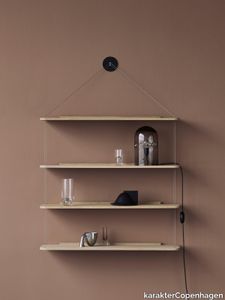
karakterCopenhagen > Cabinet
Originally designed in 1957, perfected over the years, and produced by Bernini in 1966. Seeking to pare down the structure of a bookcase to the absolute minimum, Castiglioni decided to hang the shelves on knots in two cords fixed to a single point on the wall. 50 years after it was launched it is still relevant, elegant, and very Castiglioni.
Pivot Aldo Bakker, 2014

karakterCopenhagen > Styling
Silver with gold on top. A playful and chunky shape with a fine and delicate structure around the lid. All contrasting to the full-blown extravagance of the materials. 100% fine silver, plated with gold. Aldo Bakker, “I question the most common significance of products and thus also their use. In an ideal situation, every object takes on its own character and gains its own legitimacy. My designs are not based on fashion. They are unique pieces, not necessarily understandable at a glance, but meant for a slow, layer by layer exploration.”
Fat One Aldo Bakker, 2015
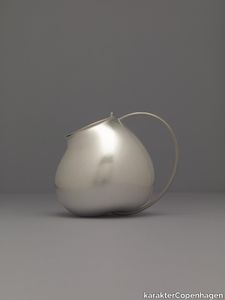
karakterCopenhagen > Styling
“My designs are not based on fashion. They are unique pieces, not necessarily understandable at a glance, but meant for a slow, layer by layer exploration.” Much like all other designs by dutch Aldo Bakker this intriguing shape is designed to surprise. The bottom of Fat One resembles an apple. And where you’ll normally find the stem of the apple, Bakker has connected one end of the handle. The other end is connected to the opening and lid. Fat One is made in silver, bent through electro forming and grown around a perfect model using CNC milling to ensure the precise positioning of the handle. The handle is made in steel, to ensure enough strength to hold the Fat One.
TriAngle Aldo Bakker, 1996

karakterCopenhagen > Stool
The Dutch designer, Aldo Bakker, is known for his uncompromising approach to design. This is a perfect example of his work. TriAngle consists of 12 triangular elements—cut to fit together like the perfect puzzle. The final puzzle reveals a square stool or side table with a distinguished and very precise look. The sharp corners and visible cuts will become softer and gain patina over time, making tear, wear and decay a very essential part of this design. Aldo Bakkers’ work has a delicate and rare sense of harmony and his ideas are always intended to trigger a response. He wants to challenge us with his design, to make us stop our everyday routines for a minute and ponder over an odd little feature, hopefully making us perform our everyday casual acts with more attention.
Chair 300 Joe Colombo, 1965
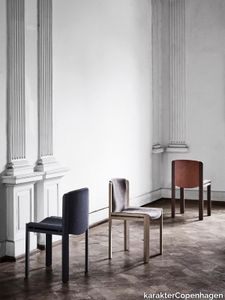
karakterCopenhagen > Chair
Designed by the forward-thinking Italian designer Joe Colombo, Chair 300 is a beautiful example of his functional design sensibility. Upholstered seat and back gently curved inside a modest, clear wooden frame with double horizontal slats give Chair 300 its appealing, comfortable and characteristic look.
Comodo Achille Castiglioni, 1988

karakterCopenhagen > Cabinet
Poised on a slim metal stem, Comodo’s wood cabinet is set off-centre with a lidded compartment. Castiglioni and Pozzi’s elegant multi-purpose unit can be used as a bedside table, a tray, a coffee table or simply as a storage box for all your favourites. Supposedly Castiglioni, being a big fan of sweets, used his own Comodo to store candy.
Lungangolo Achille Castiglioni, 1991
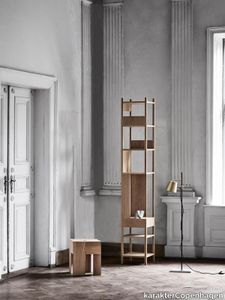
karakterCopenhagen > Styling
Castiglioni is said to ponder a lot on lost space. Empty inches and square meters that could be filled with beautiful design—but for some reason just never were. Due to this thinking he did many designs intended specifically for the corners of the home. Lungangolo is one of those. Lungangolo is a multi-use piece of furniture originally produced by Bernini. The frame is made of four slender pillars with square cross-sec-tions in between to support the square shelves placed in various heights. The structure is strengthened by a drawer and a side piece. The position of the drawer and elimination of part of the support meant it had to be manufactured in two versions—to work for both left and right handed.
Clessidra Vase Joe Colombo, 1969
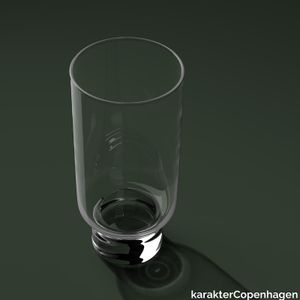
karakterCopenhagen > Styling
Prolific Italian architect and designer Joe Colombo created a wide array of appealing glass objects in his time. He worked with shapes, light, and silhouettes, and had an impressive way of creating small sculptures out of even the most functional homeware pieces. Clessidra vase is a timeless and beautifully scaled glass object, where the container of the vase is raised gracefully from the light base to lift the flowers up in the air. Colombo’s original drawings from 1969 shows a unique idea for a range of multiuse glass objects based on geometrical figures. One of these being the tall, slender Clessidra vase.
Console Table Aldo Bakker, 2017
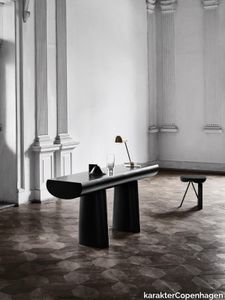
karakterCopenhagen > Console
Tranquil and seductive, Aldo Bakker’s Console Table floats exquisitely between sculpture and furniture. It depicts the simplest concept of a table: two columns and a surface. The legs are an elongation of the line created by the tabletop. The tabletop and the base of the legs have the same width, making them equally important to the design. The distance between the legs is not fixed, but can be changed as preferred, adding to the sculptural quality of this piece.
Coffee Table Aldo Bakker, 2015
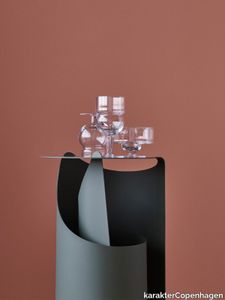
karakterCopenhagen > Coffee table
A single sheet of steel rolled in one smooth motion into a self-supporting construction. Aldo Bakker’s exquisite sense of merging colour, material and form has come into play to create an occasional table with an effortlessly sculptural appeal.
Lab Light Table Anatomy Design, 2010

karakterCopenhagen > Table lamp
The Lab Light design came about from a genuine fascination with laboratory equipment and with all those fantastic clamps and levers — the perfect place to start designing a multi-functional lamp. The base is porcelain, the stem is painted steel, and the lampshade and rotating arm is brass.
Lab Light Floor Anatomy Design, 2010

karakterCopenhagen > Floor lamp
The Lab Light design came about from a genuine fascination with laboratory equipment and with all those fantastic clamps and levers — the perfect place to start designing a multi-functional lamp. The base is porcelain, the stem is painted steel, and the lampshade and rotating arm is brass.
Steel Lab Light Floor Anatomy Design, 2010

karakterCopenhagen > Table lamp
Inspired by her parents’ pharmaceutical work and their old lab equipment, Andrea Kleinloog from Anatomy Design designed the Lab Light mixing steel, brass and porcelain. This brought on a desire to make a lamp with a younger feel. Base, lampshade, and rotating arm—all in painted aluminium.
Steel Lab Light Table Anatomy Design, 2010

karakterCopenhagen > Table lamp
Inspired by her parents’ pharmaceutical work and their old lab equipment, Andrea Kleinloog from Anatomy Design designed the Lab Light mixing steel, brass and porcelain. This brought on a desire to make a lamp with a younger feel. Base, lampshade, and rotating arm—all in painted aluminium.
Middleweight Pouf Michael Anastassiades, 2021
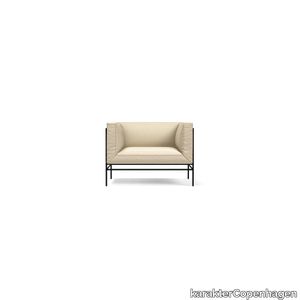
karakterCopenhagen > Chair
The Middleweight sofa captures the best of two worlds, the Italian super lounge sofa on one side and the compact Danish box sofa on the other. Set on a thin, open steel frame, the cushions are firmly held together by zippers and carefully mitered in the corners of the frame, resembling the sharp edges of folded paper. Middleweight is a luxuriously comfortable sofa, available as an arm-chair, 2-seater or 3-seater sofa and pouf. “This was my first sofa design, but actually the biggest surprise didn’t come until the product was finalized – when we stood there, looking at the actual sofa, and it looked exactly like what I had in my head. It is a great satisfaction as a designer. You can’t accelerate the process of design. An idea has to come when the time is right, so you have to stretch the process as long as possible and allow for enough time to get the ideas and experiments across.”
Middleweight armchair Michael Anastassiades, 2021

karakterCopenhagen > Chair
The Middleweight sofa captures the best of two worlds, the Italian super lounge sofa on one side and the compact Danish box sofa on the other. Set on a thin, open steel frame, the cushions are firmly held together by zippers and carefully mitered in the corners of the frame, resembling the sharp edges of folded paper. Middleweight is a luxuriously comfortable sofa, available as an arm-chair, 2-seater or 3-seater sofa and pouf. “This was my first sofa design, but actually the biggest surprise didn’t come until the product was finalized – when we stood there, looking at the actual sofa, and it looked exactly like what I had in my head. It is a great satisfaction as a designer. You can’t accelerate the process of design. An idea has to come when the time is right, so you have to stretch the process as long as possible and allow for enough time to get the ideas and experiments across.”
Middleweight 2-seater Michael Anastassiades, 2021

karakterCopenhagen > Chair
The Middleweight sofa captures the best of two worlds, the Italian super lounge sofa on one side and the compact Danish box sofa on the other. Set on a thin, open steel frame, the cushions are firmly held together by zippers and carefully mitered in the corners of the frame, resembling the sharp edges of folded paper. Middleweight is a luxuriously comfortable sofa, available as an arm-chair, 2-seater or 3-seater sofa and pouf. “This was my first sofa design, but actually the biggest surprise didn’t come until the product was finalized – when we stood there, looking at the actual sofa, and it looked exactly like what I had in my head. It is a great satisfaction as a designer. You can’t accelerate the process of design. An idea has to come when the time is right, so you have to stretch the process as long as possible and allow for enough time to get the ideas and experiments across.”
Middleweight 3-seater Michael Anastassiades, 2021

karakterCopenhagen > Chair
The Middleweight sofa captures the best of two worlds, the Italian super lounge sofa on one side and the compact Danish box sofa on the other. Set on a thin, open steel frame, the cushions are firmly held together by zippers and carefully mitered in the corners of the frame, resembling the sharp edges of folded paper. Middleweight is a luxuriously comfortable sofa, available as an arm-chair, 2-seater or 3-seater sofa and pouf. “This was my first sofa design, but actually the biggest surprise didn’t come until the product was finalized – when we stood there, looking at the actual sofa, and it looked exactly like what I had in my head. It is a great satisfaction as a designer. You can’t accelerate the process of design. An idea has to come when the time is right, so you have to stretch the process as long as possible and allow for enough time to get the ideas and experiments across.”
Rampa Achille Castiglioni,Pier Giacomo Castiglioni, 1965

karakterCopenhagen > Desk
Rampa, a multifunctional station on wheels from 1965, was inspired by the traditional florist’s display stands found on Italian town squares. On one side, the steps serve as a bookshelf with the four steps being covered with tempered glass plates, and a compartment in the lower large step, which is closed with a flap door. At the opposite side of Rampa, there are two visible compartments for storage as well as a larger flap that, when opened, acts as a writing desk, and reveals two more compartments, and six drawers. Thanks to the four castors, two of which has brakes, the object can easily be moved around or fixed.
Side Table No. 2 PlueerSmitt, 2014

karakterCopenhagen > Side table
Striking. Wooden side table consisting of two stripped-down trestles and a table top. The seemingly heavy top contrasts the rigid trestles. The top gives in and provides space for the sharp ends of the trestles to lock the legs and the top together. Intriguing shapes, familiar yet not at all, balancing between art and design. Viewed from different angles the side table varies greatly. A design meant to puzzle our understanding of shape, form and function.
Cache Console Paul McCobb, 1952
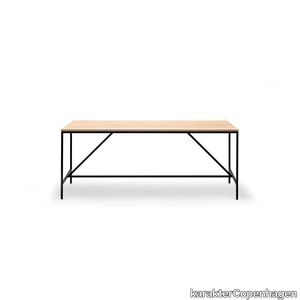
karakterCopenhagen > Console
The foundation of the Cache series, part of Paul McCobb’s extensive Planner series, is a beautifully simplistic and easy table with slim and straight steel legs, stripped from any details or ornament, leaving only small drawers that can be mounted individually or grouped on either side of the table for small keepings. The series is complimented with the matching Desk Organiser with two drawers and a shelf supported by a steel frame. A prominent figure in American mid-century design, Paul McCobb conceived the Planner series in the 1950s, a modular furniture series that brought modern design into middle-class American households. The aesthetic attribute of McCobb’s design is sleek and unadorned and at the same time warm and approachable. With its versatility and purity of form, the Planner series became one of the most successful commercial furniture lines of its era.
Principal chair Bodil Kjær, 1961
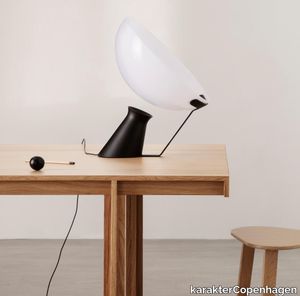
karakterCopenhagen > Chair
One of the last living mid-century Scandinavian design pioneers and a female pioneer in the field of architecture in her time, Bodil Kjær, conceived her Principal series in 1961 as part of an architectural exploration of interior solutions for modern living, called Elements of Architecture. Comprising a dining table and an upholstered dining chair, the Principal series epitomises Kjær’s forward-thinking cosmopolitan outlook and modernistic design language that slips fluidly into contemporary interior. The solid wood dining table boasts a clarified form, repeating a simple angle throughout table legs and ends of the table top, while the dining chair with its circular seat and gently rounded backrest, beautifully upholstered, adds a softness to the clear, unfussed geometry, an invitation to linger.
Cache Dining table Paul McCobb, 1952

karakterCopenhagen > Desk
The foundation of the Cache series, part of Paul McCobb’s extensive Planner series, is a beautifully simplistic and easy table with slim and straight steel legs, stripped from any details or ornament, leaving only small drawers that can be mounted individually or grouped on either side of the table for small keepings. The series is complimented with the matching Desk Organiser with two drawers and a shelf supported by a steel frame. A prominent figure in American mid-century design, Paul McCobb conceived the Planner series in the 1950s, a modular furniture series that brought modern design into middle-class American households. The aesthetic attribute of McCobb’s design is sleek and unadorned and at the same time warm and approachable. With its versatility and purity of form, the Planner series became one of the most successful commercial furniture lines of its era.
Castore dining table Angelo Mangiarotti, 1975
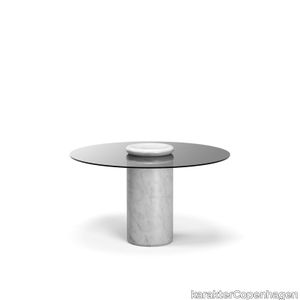
karakterCopenhagen > Table
Castore is a glass and marble table by Italian architect, sculptor and designer Angelo Mangiarotti. Designed in 1975 for Sorgente dei Mobili, the distinct design is now presented by Karakter, available as a 130cm dining table. The round glass top rests on a heavy marble pillar, and visually, Mangiarotti would have it seem that only a small marble bowl on top of the glass plate is holding it in place. The rounded corners on both the pillar and the bowl ads a sense of softness to the otherwise heavy aesthetics of the marble. The marble bowl can be removed and used as an individual element. However, keeping it as an integral part of the design, you can enjoy additional rounded corners, as the bowl reflects in the glass table top.
Cache desk organiser Paul McCobb, 1952

karakterCopenhagen > Cabinet
The foundation of the Cache series, part of Paul McCobb’s extensive Planner series, is a beautifully simplistic and easy table with slim and straight steel legs, stripped from any details or ornament, leaving only small drawers that can be mounted individually or grouped on either side of the table for small keepings. If more storage and distinctiveness is needed, add the second piece in the series, the two-drawer organizer that resides on a slender leg construction as the table itself and has the same playful two-finger opening system as the drawers in the desk. The Desk Organiser can be placed on the desk or used as a stand-alone item next to sofas or beds.
Recently Viewed Products
A wide range of product from furniture to finishes to meet the desire of all designers.
Frans
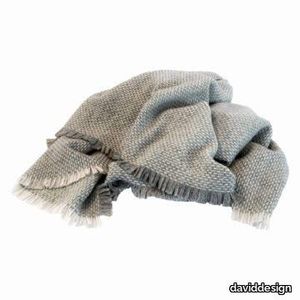
daviddesign > Styling
The Frans blanket is made of 100% lamb’s wool, has fringes around all edges.
Lari Angelo Mangiarotti, 1978

karakterCopenhagen > Table lamp
The Lari Lamp, mouth blown in one single piece, that are held together by the base, which also supports the electrical system evokes, on a small scale, some suggestions of Angelo Mangiarotti’s previous architecture.
Cache Dining table Paul McCobb, 1952

karakterCopenhagen > Desk
The foundation of the Cache series, part of Paul McCobb’s extensive Planner series, is a beautifully simplistic and easy table with slim and straight steel legs, stripped from any details or ornament, leaving only small drawers that can be mounted individually or grouped on either side of the table for small keepings. The series is complimented with the matching Desk Organiser with two drawers and a shelf supported by a steel frame. A prominent figure in American mid-century design, Paul McCobb conceived the Planner series in the 1950s, a modular furniture series that brought modern design into middle-class American households. The aesthetic attribute of McCobb’s design is sleek and unadorned and at the same time warm and approachable. With its versatility and purity of form, the Planner series became one of the most successful commercial furniture lines of its era.
Linkfloor Multiformat Silver 3"/6"/9"X60"
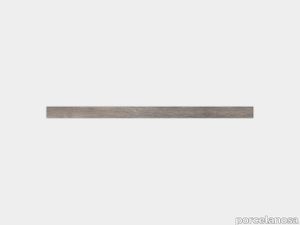
porcelanosa > Carpet
gray wood effect vinyl. Size 3/6/9x60 in, suitable for interior floor.
forte tile Pacific
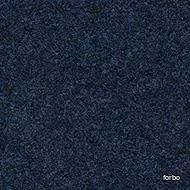
forbo > Carpet
Forte tiles combine the ease of handling, optimized installation and maintenance benefits of modular flooring, with all the durability and economic advantages of a needlefelt floor. Forte tiles are based on the Forte sheet construction and use the same polyamide structure with latex binder and fibre backing layer.Forte tile is a premium needlefelt floor covering, the very dense texture provides an attractive appearance and wear-resistant performance.Available in a select range of 12 commercial colour options.All colours are also available in a sheet format.
N°304CA - Adjustable wall lamp with swing arm _ DCWéditions
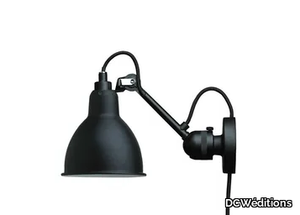
DCWéditions > Wall lamp
The N°304 CA is a versatile wall and floor spotlight featuring a complete cable with a plug and switch, designed without a switch on the cast, making it ideal for placement at a bedhead. Crafted with a steel base and arm, this lighting fixture is Class II rated, supports an E14 bulb, and is compatible with LED or FLUO bulbs up to 11W. Known for its discreet and elegant design, the N°304 series has become a hallmark in lighting, offering adjustability and directionality, though it is best suited for stationary use rather than frequent repositioning. The product is available in six configurations, including options with different arm lengths and specific models for bathrooms with IP65 rating. Additionally, a 3D file of the product is available for download, allowing for detailed visualization and planning. DCWéditions, the supplier, is a prestigious French design house established in 2008, celebrated for its innovative and contemporary lighting and furniture collections that blend functionality with timeless aesthetics. Inspired by the iconic designs of Bernard-Albin Gras, whose groundbreaking work in the 1920s revolutionized industrial and office lighting, DCWéditions continues to honor his legacy by producing pieces that are both ergonomic and visually striking. The company’s commitment to quality and design excellence is evident in their diverse range of products, which cater to both residential and commercial spaces, making them a trusted name in the world of interior design.
WA-T - Contemporary style LED dimmable wall light _ Deltalight
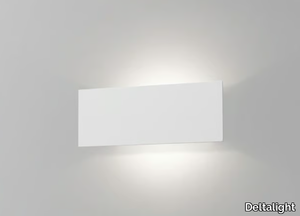
Deltalight > Wall lamp
The Wa-T luminaire creates a striking visual effect, giving the illusion that a section of the wall is gently floating away, enhanced by its indirect lighting. Available in black-matt gold and white finishes, the black option features a warm, soft glow from its inner matt gold surface, adding a touch of elegance. Technical specifications include two LED options: 1 x 7.5W (CRI>90, 3000K, 700lm) and 1 x 9W (CRI>90, 3000-2000K, 690lm), with an IP20 rating. A downloadable 3D file of the product is also available for design integration. Deltalight, a renowned Belgian-based lighting supplier founded in 1987, specializes in premium, innovative lighting solutions for both residential and commercial spaces, offering a blend of modern, contemporary, and minimalist designs.
LOGIC W L F - LED wall-mounted outdoor metal steplight _ Deltalight
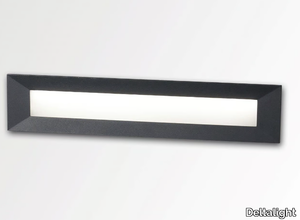
Deltalight > Functional light
The Logic series represents a comprehensive collection of water- and shock-resistant lighting fixtures, designed to deliver powerful illumination through advanced LED arrays, making them ideal for both wall and floor recessed applications. These fixtures enhance the architectural and landscape aesthetics of any project, offering versatile reflector options to accentuate trees, sculptures, facades, or garden features, while also providing functional lighting for pathways and driveways. Available in Alu grey, white, and dark grey, the Logic series features a 9.5W LED cluster with a CRI >80, 3000K color temperature, 1480lm output, IP65 rating, and energy class D. A downloadable 3D file of the product is also available for detailed planning and visualization. Deltalight, a renowned Belgian lighting manufacturer founded in 1987, specializes in high-end, innovative lighting solutions for both residential and commercial spaces, offering a wide range of products, including custom designs, known for their premium quality and elegant aesthetics.
NEEDLE TRC OK - LED adjustable spotlight _ Deltalight
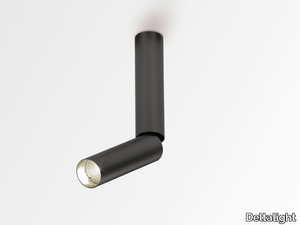
Deltalight > Ceiling lamp
The Needle spotlight collection, with its slender and elegant design, adds a sophisticated touch to any space, allowing for creative combinations or standalone use to highlight its minimalist charm. Available in Flemish gold and black bronze, the collection features adjustable lighting with options for 2700K or 3000K color temperatures, a high CRI (>90), and energy-efficient LED modules (3.9-5.7W, 385-519lm) with lens options of SP-13° or FL-33°. With an IP20 rating and energy class F, it is ideal for indoor applications. A downloadable 3D file of the product is available for design planning. Deltalight, the supplier, is a globally recognized leader in high-end lighting solutions, founded in 1987 and headquartered in Belgium, renowned for its innovative designs, premium materials, and elegant aesthetics tailored for luxury residential and commercial projects.
METRO - LED adjustable ceiling lamp _ Fabbian
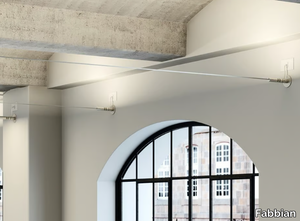
Fabbian > Ceiling lamp
Metro is a sleek and luminous graphic sign, designed with a minimalist yet striking concept: a straight, broken, or diagonal metal band that effortlessly enhances various environments. This innovative lighting solution addresses a common challenge in both modern and traditional spaces—effectively illuminating large rooms with high, exposed-beam, vaulted, or painted ceilings that often lack sufficient light points. Metro not only meets these needs but also offers versatile installation options, allowing the luminous strip to be arranged straight, diagonally, or in custom designs, thanks to its adjustable wall attachments. Available in 6m and 12m lengths with a stainless-steel finish, the LED light source provides uniform illumination, with the flexibility to create direct or indirect lighting effects. A standout feature is the jointed ends, which enable diagonal or curved arrangements using a special accessory. The collection includes wall and ceiling fixtures, making it ideal for interiors. Additionally, a downloadable 3D file of the product is available for design planning. Fabbian, the Italian lighting specialist behind Metro, has been crafting high-quality, innovative lighting solutions since 1961, combining contemporary design with functional elegance for homes, offices, and commercial spaces worldwide.
Recommended Products
A wide range of product from furniture to finishes to meet the desire of all designers.
Lunat
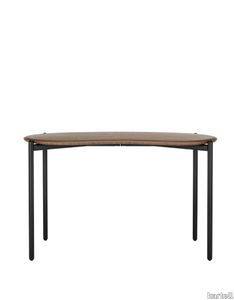
kartell > Desk
The LUNAT desk, designed by Patricia Urquiola, creates the ideal solution for a home smart working station as well as a desk in a hotel room. The powder-coated legs grow slender up to the bean-shaped top; the top is available in flamed walnut finish.
PK52A Student Desk
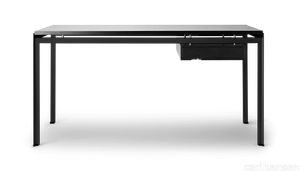
carlhansen > Desk
Poul Kjærholm created the PK52A Student Desk by bringing wood and steel together in a clean, light construction. With its pared-down expression the desk is a perfect example of Kjærholm’s great contribution to Danish design.
CH110 Desk
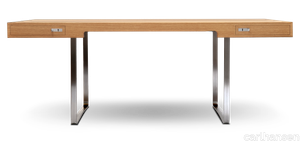
carlhansen > Desk
Hans J. Wegner’s CH110 desk stands out in many ways from his usual style of solid-wood furniture. Created in 1970, it was part of an exclusive office concept. The series features some of Wegner’s most distinctive steel-framed furniture.
AJ52 Society Table
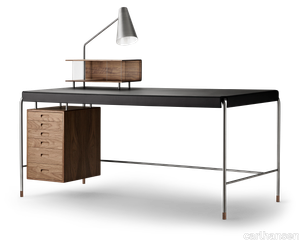
carlhansen > Desk
Created in 1952 for the American-Scandinavian Foundation’s New York office, Arne Jacobsen’s elegant AJ52 Society Table is a fluid fusion of Bauhaus, functionalism and industrial design.
pp571
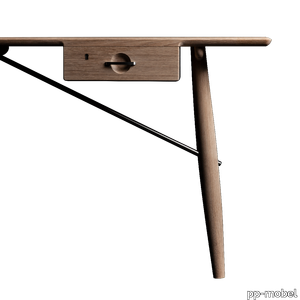
pp-mobel > Desk
Hans J. Wegner designed the exquisite pp571 Architect’s Desk in 1953 as a match to the Round Chair. Later in 1955 he designed the Swivel Chair, completing a line of exclusive masterpieces for the CEO’s office. The desk marks the beginning of Wegner’s work on combining sharp steel and sculptural solid wood in elegant and well-balanced solutions.
pp305

pp-mobel > Desk
This is classic Danish craftsmanship offering simple and modest functionality in solid wood. As a counter experiment, this desk pays homage to pure, traditional and exquisite woodwork. Although the thorough and dedicated attention of a skilled cabinetmaker is required in executing the work on this desk, the job can be done with relatively simple tools.
Journal Desk White
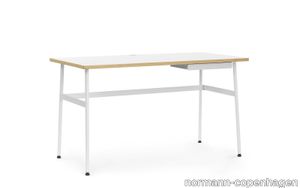
normann-copenhagen > Desk
Laminated tabletop with oak edge, powder coated steel legs, steel drawer, painted in same color as tabletop and legs. Silicone rosette at hole for power-cords.
Home office Penrose Desk
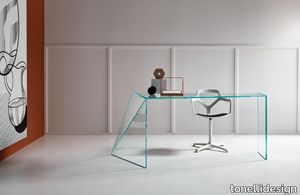
tonellidesign > Desk
Penrose desk, designer home office desk, was created by Isao Hosoe together with Lucia Fontana and Masaya Hashimoto. It represents the aesthetic and functional metaphor of man’s challenge to exceed nature and its equilibria through the use of glass, and results as the ideal furnishing complement for the studio. The asymmetric structure in transparent glass, also available in extra clear finish, is able to create a perfect balance between the finely cut glass slabs.
Home office Bacco
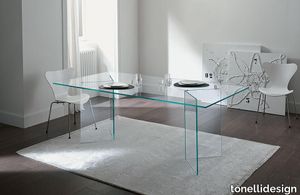
tonellidesign > Desk
The glass table Bacco is composed of a top available in transparent, extra clear or smoked glass and of a base made of two mirroring glass supports that rest on the floor. Its clean lines are particularly suited for minimalistic decors because they do not burden the environment. The transparency makes the room brighter and creates a broader effect. Perfect for luxury studios and offices, dining rooms and lounges, the glass table Bacco can be ordered in different sizes according to needs. The glass of this designer table is resistant and tempered, which makes it also suitable for working areas and dining rooms.
Home office Marcell
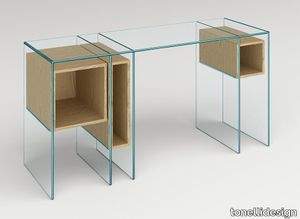
tonellidesign > Desk
Marcell, timeless design furniture, born from a project by Massimo Castagna, and is characterized by the essential and rigorous lines of glass combined with the warmth of wood, in a versatile piece of furniture in all its forms. The extra clear or smoked glass structure was born as a desk, but thanks to the modularity of its components, it can also be used as an entrance console and if equipped with drawers or a mirror, also as a dressing table for the sleeping area. The containers, available in Eucalipto, Siberian Ash or Natural Oak wood, have the additional option of hinged doors on the left or the possibility of inserting a set of three drawers in a matching finish. To complete the offer, the mirror from the same collection with a polished chrome base.
The Living Workspace
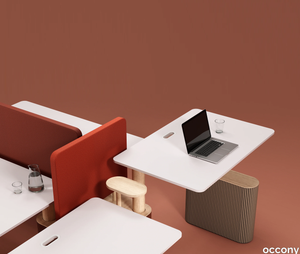
occony > Desk
Occony introduces The Living Workspace, our latest collaboration with designer Robert Bronwasser. The Living Workspace is a modern workspace concept, inspired by nature, with organic shapes and smart solutions that promote functionality, connection and well-being, even in the most business-like environments.The Living Workspace is a modular system that is customizable in size, direction, composition and color & finishes. It acts as an innovative replacement for conventional workplaces and promotes innovation, social interaction, and various forms of collaboration. As well, it offers the opportunity to create quiet, ergonomic workplaces for individual work.Our workplaces are acoustically optimized, electrically height-adjustable, and comply with the NPR 1813 and NEN 527 guidelines for sit-stand workplaces.
TMNL front workstation

gispen > Desk
Gispen TMNL is a modular desk and (conference) table range, specially designed for intensive use. Ideal for dynamic organisations that place high demands on multifunctional office design, with an eye for sustainability. The frame, top and base are easy to assemble and the desired height is easy to adjust.
TMNL four-pack workstation
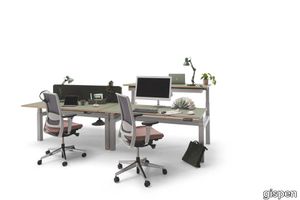
gispen > Desk
Gispen TMNL is a modular desk and (conference) table range, specially designed for intensive use. Ideal for dynamic organisations that place high demands on multifunctional office design, with an eye for sustainability. The frame, top and base are easy to assemble and the desired height is easy to adjust.
TMNL doc workstation

gispen > Desk
Gispen TMNL is a modular desk and (conference) table range, specially designed for intensive use. Ideal for dynamic organisations that place high demands on multifunctional office design, with an eye for sustainability. The frame, top and base are easy to assemble and the desired height is easy to adjust.
IC solo workstation
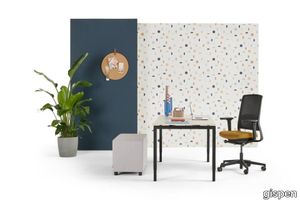
gispen > Desk
This design is so powerful because all unnecessary details have been left out. IC is a minimalist desk and conference table collection with slender open frames and a floating top, keeping its surroundings visually open. Its sleek design makes IC suitable for any environment. There are different tabletop sizes to choose from, which makes this collection very multi-functional. What is a desk today, can become a conference table tomorrow.
IC solo workstation
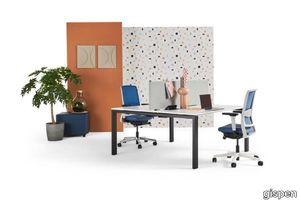
gispen > Desk
Gispen IC is a minimalist desk and conference table range with slender, open frames and suspended tops. The design creates the appearance of an open environment. Generous surface dimensions make the tables multifunctional. Extra-large table leg bridges provide maximum legroom while also reducing the use of materials.
Home office desk sit-stand (electric)
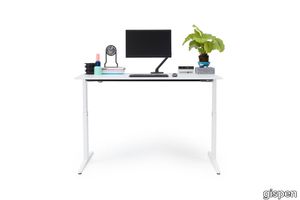
gispen > Desk
This sleek and sustainable desk will ensure that you keep your body in motion. The electric height-adjustment system makes it easy to alternate between a seated and a standing position. You can set the tabletop to your preferred height with the push of a button. Ideal when you want to regularly alternate between postures, or when more than one person makes use of the home office desk. The desk meets the highest of ergonomic requirements and will suit any home office environment. The height of the tabletop can be adjusted to a quarter of an inch via the screw adjustment. When combined with an ergonomic office chair, you will have a fully-fledged ergonomic and comfortable home office space.
TEAM Wood high table

gispen > Desk
Holding a meeting, conferring, completing a task: TEAM does it all. The basic principle of the TEAM table system is that it supports various work methods and comes in many shapes and sizes. Mix and match the various components to design the perfect table for any type of space.
mathieu
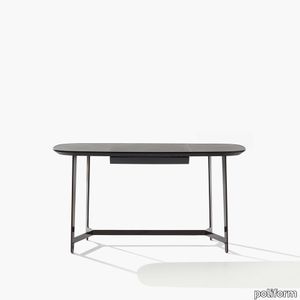
poliform > Desk
Mathieu is a contemporary desk characterised by a slender silhouette and graceful contours. The top, with a wood frame and leather insert, traces subtle curves that soften the strong lines of the painted metal structure. The optional accessories – the small drawer under the top and the mirror – are elegant and discreet, making it a perfect complement for bedroom spaces.
home hotel
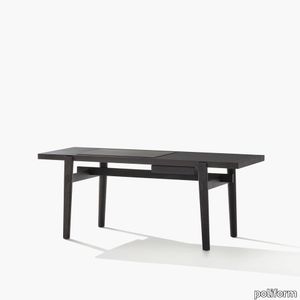
poliform > Desk
Elegance and versatility are the common elements of the Home Hotel collection, which reinterprets contemporary living spaces in a lifestyle-based approach. The desk, solid and light, is available with or without a drawer and leather top.
concorde
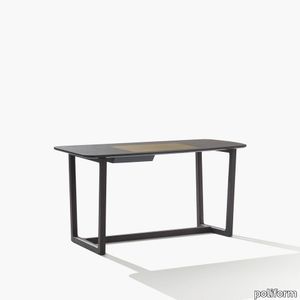
poliform > Desk
The light and essential shapes of the Concorde table are reinterpreted in the form of a writing desk, an essential component to create a dedicated home study area. The materials have been carefully selected, including solid wood and sophisticated finishes. Concorde is available with or without a drawer and leather top.
Eames Desk Unit EDU

vitra > Desk
The Eames Desk Unit (EDU) was constructed by Charles and Ray Eames in accordance with the principles of industrial production. The panels function as a modesty shield and partially enclose the two storage compartments. The desk is height-adjustable to accommodate uneven floors.
Home Desk
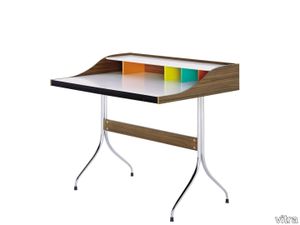
vitra > Desk
High-quality materials emphasise the graceful refinement of the Home Desk by George Nelson, originally designed in 1958 as a lady's writing table. Today the compact desk tends to be used in home offices, where it adds an appealing decorative accent with its multicoloured compartments.
CPH Table CPH 10
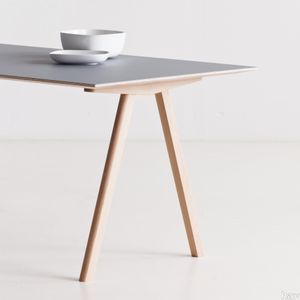
hay > Desk
Featuring the same understated expression and focus on functionality as the rest of the series the CPH10 has symmetrical legs with a more generous tabletop creating a larger workspace and greater flexibility. The oak frame is available in different finishes and the tabletop comes in a variety of wood or linoleum options that make it suitable for using in a wide range of corporate and public contexts.
CPH Table CPH 190 Desk

hay > Desk
Sharing the same angled legs as the rest of the series the tabletop of the Moulded Plywood Desk CPH190 features a split at the back of the table creating a useful upright backrest for supporting notes and open books while the remainder serves as workspace. This has the dual benefit of making the desk more compact at the same time it increases functionality. Ideal for using in a home office or in a work environment it is crafted in oak with a clear lacquer.
D.847.1
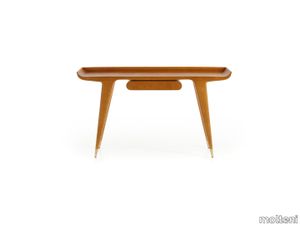
molteni > Desk
More than 70 years after its original design the D.847.1 console table is reborn thanks to the Heritage Collection reissue project by Molteni&C in collaboration with the Gio Ponti Archives.
Scriba
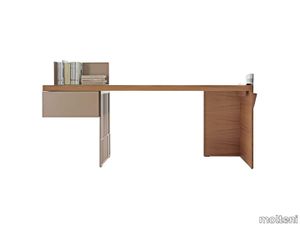
molteni > Desk
A desk with very clean lines and a decoratively perforated top support element that conveys a sense of lightness. Wood surfaces a practical lateral drawer a clever book support element in painted sheet metal and a side pocket in hide leather complete the desk. The bookend support leans on the top and it can be positioned in the desired direction.
UPHOLSTERY
A wide range of Upholstery and materials provided by our suppliers to satisfy your needs.
AI services
Fringe Chatbot | Image Finder | Fringe Dall-e | Area Analyzer


